INTRODUCTION
Latin America witnessed a resurgence of social movements and protests during the
1990s and early 2000s (Almeida, 2007; Silva, 2015). While in the 1980s citizens demanded
the end of military rule and the reestablishment of democracy, in the 1990s mobilizations
targeted the political elites who had endorsed the neoliberal doctrine of the Washington
Consensus. In several countries, citizens took to the streets to challenge the privatization
and liberalization of pensions, healthcare and education and to manifest their discontent
with rising inequalities and poverty rates. This situation began to change in the decade of the
2000s when the region experienced a period of sustained social policy expansion intended to
increase social protection for the many social groups outside of formal employment and not
covered by contributory social insurance (Garay, 2016). The magnitude of change was striking,
and several authors have described this period as a turn toward universalism (Franzoni &
Sánchez-Ancochea, 2016; Pribble, 2013). Almost every country in the region introduced some
form of basic social assistance, healthcare, pension and education (Cecchini & Atuesta, 2017).
Between 2002 and 2014 poverty rates in the region fell from 45.9 percent to 30.7 percent and
the Gini index decreased on average 5 percent (Comisión Económica para América Latina y
el Caribe [CEPAL], 2018).
Did popular mobilization influence the “turn toward universalism” in Latin America?
Social policy analyses have rarely considered the effect of protests and social movements
on social policy reforms. For this literature, the key factors in the study of policy change
fall in the institutional arena, in particular in the dynamics of electoral competition and
the political ideology of political parties. However, an emerging strand of the literature
has shown an influence of social organizations and protest campaigns on the creation
of programmes for vulnerable social groups. Case studies demonstrate a significant
involvement of trade unions and organizations of the unemployed throughout the process
of inception and design of the Renta Dignidad in Bolivia (2008) and the Plan Jefes y Jefas
de Hogar in Argentina (2001) (Anria & Niedzwiecki, 2016; Garay, 2007). This literature shows
that innovation in social policy was driven by popular movements, and that the alignment
of popular demands and government’s agenda was a difficult and time-consuming process
involving negotiations both within and outside political institutions.
Latin American countries have a long, recurring history of popular movements demanding
greater equality, inclusion and democratization (Almeida, 2007). The latest of such protest
waves occurred at the turn of the century. Scholars of the left turn in Latin America have
focused on the electoral victories of left-wing parties and coalitions across the region
started with the election of Hugo Chávez in Venezuela in 1998, relating these outcomes with
widespread social discontent towards the liberalization of the 1990s (Arditi, 2008; Beasley-
Murray, Cameron, & Hershberg, 2009b; Levitsky & Roberts, 2011; Silva, 2009). Some authors
have interpreted this period as the struggle for (re)incorporation of those groups that
suffered exclusion during the heyday of neoliberalism (Rojas, 2018; Rossi, 2017), while others
have seen the governments of the left turn as more willing to undertake social welfare roles
(Levitsky & Roberts, 2011). Overall, the main goal of this literature was either to explain a
certain political outcome –the electoral victories of the Left– or political process –the rise of
grassroots movements–, but the social policy dimension was not central or was regarded as
a by-product of political change.
The aim of this paper is to extend current theoretical frameworks used to explain the
inclusive turn in Latin American social policies by incorporating protest. We argue that social
policy reform is shaped by the broader configuration of the polity, in particular by the ways
in which contentious and institutional politics interact and shape each other (Fourcade &
Schofer, 2016). Thus, we do not contend the relevance of electoral dynamics and political parties, but rather that differences in the ways in which institutional and contentious politics
combine affect the policy process and the very chances of some reforms to be considered
and implemented. The paper is organized as follows: first it elaborates on the mechanisms
linking protest and expansive social policy reforms; it proceeds by presenting empirical data
on contention in the region in the period 1990-2010 and the relationship between protest, the
strength of the left and social policy outputs in healthcare and social assistance (conditional
cash transfers and non-contributory pensions). The final section offers concluding remarks
about the role of protest in the politics of social policy reform in the region.
THE CONTENTIOUS POLITICS OF SOCIAL POLICY REFORMS
Studies of the inclusive turn of the 2000s in Latin America stress the importance of a
combination of economic, institutional and political factors, in particular the increase in
governments’ resources due to the rise in commodity prices and the strength of the Left across
the region (Huber & Stephens, 2012; Levitsky & Roberts, 2011). These factors are important
but only look at political dynamics within the electoral arena. In this section we make a case
for expanding these theoretical frameworks to incorporate the influence of protest on the
decision of governments to expand social protections for marginalized social groups.
Social policy reforms are the outcomes of power relations and political struggles. Political
parties are crucial actors in policymaking, and parliaments are one of the main settings
where social conflict is mediated, popular demands accommodated and diverging interests
negotiated. However, formal institutions are not the only arena of political exchange, and
Latin America provides strong evidence of the power of contentious politics (Almeida, 2007;
Silva, 2015). It is not uncommon in the region for protests to scale up into large episodes of
unrest (e.g. the uprising in Chile of October 2019, the December 2001 protests in Argentina,
or the water wars in 2000 in Bolivia). These can undermine the capacity of authorities to
govern and might lead to systemic impacts such as transformations of the party system.
Furthermore, groups such as the poor, the young, the unemployed and those in the informal
economy are often comparatively less inclined to vote and to join political parties, thereby
reinforcing a trend of underrepresentation of their interests in political institutions (Offe,
2013). Compared to electoral politics, the protest arena is more open to political actors
who lack regular access to institutional channels, and thus enhances political participation
among traditionally excluded constituencies (Kriesi, Koopmans, Duyvendak, & Giugni, 1995).
As such protest is an important channel for outsiders to make demands for more egalitarian
social policies.
Drawing on studies on the outcomes of social movements, we identify a two-way
relationship between collective mobilizations and social policy (Amenta, Caren, Chiarello,
& Su, 2010; Giugni, 2008). On the one hand, social policies create categories of people
(the beneficiaries of a programme, those excluded from social security). Over time these
categories can solidify in collective identities and organizations which mobilize to further
their interests. On the other hand, scholarship suggests a number of mechanisms through
which protesters can force governments to take their demands on board. Governments can
be induced to negotiate with protesters because they have an interest in reducing social
conflict and maintaining peaceful societies. Protests also serve as signals that indicate
pressing, unresolved issues that must be addressed by governments. Governments will
be more open to consider these issues either because of their ideological proximity to
protestors, or because they mount an electoral threat – by withdrawing electoral support
or by endorsing political challengers (Ciccia & Guzman-Concha, 2018; Hutter & Vliegenthart,
2016). The extent to which these effects occur depends on the size and frequency of the
protests, but also on the capacity of protesters to sway public opinion in their favour, forge alliances with institutional actors (e.g. trade unions, political parties), develop coalitions with
other civil society organizations, and sustain and expand these linkages over times1.
The policy impact of protest can be direct, indirect or deferred. By direct impact, we refer
to short-term responses of authorities such as changes in the policy agenda of political
parties, the adoption of new measures by governments, the inclusion of representatives
of social movement organizations in the policy process (e.g. in parliamentary hearings or
committees overseeing policy implementation) (Amenta et al., 2010; Giugni, 2008). While
protest can sometimes produce short-term impacts, many effects of protest on policymaking
take time to materialize. By indirect impact, we refer to effects that occur in the middle to
long-term as a result of protests disrupting patterns of electoral competition. In relatively
consolidated democracies, social movements can become threats for officeholders and/or
improve the chances of challengers. Other indirect effects concern cultural changes produced
by protesters as a results of them entering into public opinion battles –with protestors using
their visibility and legitimacy to persuade growing numbers of people (Giugni, 2008). Indirect
impacts also include potential spill-overs effects whereby protests initially targeting a specific
policy sector (e.g. education, poverty relief) produce changes in other sectors or a larger
impact on the whole system of social protection. Finally, deferred impacts refer to policy
changes that occur long after the initial unrest was initiated. These effects can be gauged
through the historical processes of co-transformation of protestors and the political milieu
in which they act. Some of these effects occur because activists transform existing parties
from within by taking its agenda and/or leadership (Skocpol & Williamson, 2016), or enter the
political arena with their own political platforms, thus securing a stable, autonomous voice in
the institutional arena (Anria, 2018; Della Porta, Fernández, Kouki, & Mosca, 2017).
Although social movements mobilise to achieve their goals, reforms can be blocked by
other groups who see their interests or goals threatened. Also, issues might lose relevance
over time, and unforeseen events such as economic downturns can reduce governments’
room for manoeuvre and increase competition for available resources. This highlights
how the effect of protests on social policy reforms is mediated, i.e. it depends on other
components of the political environment (Amenta et al., 2010). Therefore, the shape and
extent of social policy reforms is dependent upon changes in the sites of decision-making,
including governmental offices, parliaments, corporatist institutions and policy communities.
Protest movements are more likely to obtain concessions when they are able to produce
significant changes in the existing balance of power. In Latin America power holders tend
to see social movements more as threats than as signals of unresolved social problems.
Partly, this can be attributed to problems of democratic consolidation, and to a longstanding
tradition of strong presidentialism, which poses obstacles to the development of the
civil sphere (Alexander & Tognato, 2018). Scholars have noticed that presidential regimes
exacerbate political polarization and instability (Linz, 1990) and might radicalize protests as
movements can avail of fewer points of access to the state (Kriesi et al., 1995).
PROTEST, THE LEFT AND SOCIAL POLICIES IN 18 LATIN AMERICAN COUNTRIES
In this section, we show trends in contention across the region in the 1990s and 2000s
and present an exploratory analysis of the relationship between protest, the strength of the
Left and the adoption of reforms expanding social protection for previously excluded groups.
We focus on three policies – healthcare, conditional cash transfers and non-contributory
pensions – which have been the object of intensive legislative activity aimed at extending the
coverage of social protection in the 2000s.
Figure 1 summarizes trends in protests and strikes between 1990 and 2013. We observe
that the number of protests grew all through the decade of the1990s and started to decline
in the second half of the 2000s. The 1990s were probably the most convulsed years, but in
several countries (Venezuela, Brazil, Colombia and Argentina) levels of contentions remained
high across the two decades, while in others such as Chile discontent became apparent only
in the 2000s with the rise of student protests (Guzman-Concha, 2012). The number of strikes
in turn followed a descending trajectory throughout the period. Every peak after 1990 locates
at a lower level than the preceding one. Trade unions in many Latin American countries are
traditionally weak and similarly to other regions their strength has been further declining in
the last decades.
Figure 1. Cumulative frequency of protests and strikes in 18 Latin American countries, 1990-2013
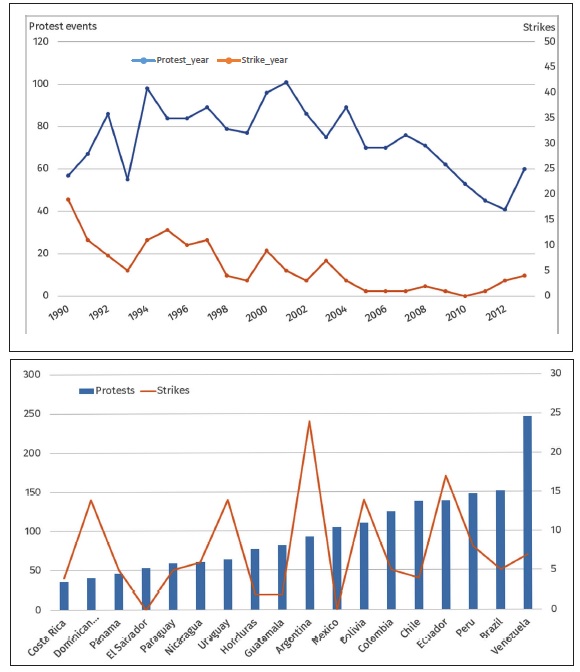
Source: Own elaboration based on Clark and Regan (2019) and Banks and Wilson (2016)
Despite these common trends, not all countries exhibited similar trajectories of social
conflict. As many as 14 per cent of 1,825 total events of protest occurred in Venezuela, which
experienced a very convulsed quarter of century in the aftermath of the Caracazo of 1989.2
According to Lopez-Maya (2003), this “was a turning point in Venezuela’s political history,
producing an irrevocable change in the relationship between state and society, above all
in the way Venezuelans gave expression to their demands and feelings of malaise”. It is
also worth noticing that Chile exhibited rather high levels of protest despite being often
depicted as an exemplar of stability in the region because of sustained economic growth and
its successful transition to democracy (Haggard & Kaufman, 2008). Other countries with a
relatively high frequency of protests are Brazil, Peru, Ecuador, Colombia, Bolivia, Mexico. The
lowest levels of contention (below 3 percent) are instead found in countries located in Central
American and the Caribbean (Costa Rica, El Salvador, Dominican Republic and Panama).
As shown in figure 1, countries with a low (or high) frequency of protest do not generally
coincide with those with low (or high) frequency of strikes (correlation=0.04). Comparing the
number of strikes and protests shows that unions have retained a central role as initiators
of large-scale collective mobilization against political authorities in Argentina, Uruguay
and Dominican Republic. The case of Argentina is emblematic of this phenomena. The
country shows a relatively low number of protest but one of the highest number of strikes
in the region. In the second half of the 1990s, community and territorial associations and
organizations of unemployed workers developed close relationships with labour unions
(Niedzwiecki, 2014). Garay (2016) talks about the emergence of social movement unions to
refer to cross-sector alliances between social movements and labour unions which led to
the formation of alternative labour-union confederations. By contrast, in countries such
as Ecuador, Bolivia and Nicaragua, unions have shared centrality with other civil society
organizations, in particular with associations of indigenous people and rural workers.
We now turn to the political contexts of protests. The political ideology of governments
has been shown to play an important role in determining their responsiveness to protest
(Ciccia & Guzman-Concha, 2018; Hutter & Vliegenthart, 2016). Figure 2 shows the relationship
between the relative power of the Left and levels of contention in the period of emergence
and consolidation of the left turn in Latin America. We include information on protests and
strikes over a longer period of time (nearly two decades) because the effect of protest on
policymaking is generally cumulative and indirect and dependent on other characteristics
of the political environment. Conversely, strong parliamentary groups can directly initiate
reforms which, if successful, will manifest their effects in the short- to medium- period
depending on political and legislative processes.
Figure 2 shows four main groups. The first pattern is characterized by the presence of
a strong Left and relatively low levels of contention (Costa Rica, Dominican Republic, El
Salvador, Nicaragua, Panama and Uruguay). The second group includes countries (Brazil,
Bolivia, Venezuela and Ecuador) with high levels of contention and a strong presence of
the Left in parliament. This group includes some of the most paradigmatic cases of the left
turn in the region. Contention levels were high also in Colombia, Argentina, Peru and Chile
where the Left was relatively weak. Finally, Paraguay, Honduras, Guatemala and Mexico show
relatively low levels of contention and a weak Left in parliament.
Figure 2. Contention (1990-2008) and left-wing seats in parliament (1998-2008)
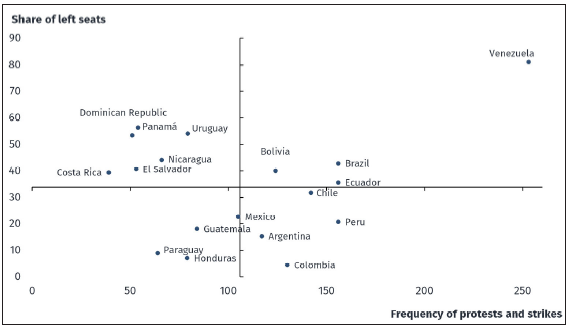
Source: Own elaboration based on Clark and Regan (2019) and Huber and Stephens (2012)
To explore the relationship between protest, the prevalence of the Left and social policies,
we looked at two sectors: healthcare and social assistance. The data on protest does not
allow to assess direct effects since it does not distinguish events based on the type of issue
raised. However, the cumulative frequency of protests provides indication about the extent
to which contention represented a regular feature of political participation across countries,
and how this affected trajectories of policy reform.
In much of the literature on outsiders in advanced economies, a pessimistic view prevails
on their ability to engage in coordinated action and influence national policies. In the face
of extensive mobilizations in several Latin American countries, it is important to identify
conditions which favours the emergence of such movements. One such condition is the
presence of social programmes that create grievances and provide a common target for
demands across societal sectors (Garay, 2016). Widespread mobilization is more likely to
coalesce around universalistic programmes such as healthcare. Therefore, we first looked
at the relationship between the cumulative frequency of protests and the share of private
health expenditure at the beginning of the period to see if social policy legacies influenced
levels of contention. Out-of-pocket expenditures have traditionally been the most important
source of financing healthcare, suggesting both insufficiency and inequity of provision
(Mesa-Lago, 2008). Figure 3 provides some evidence that several countries with higher levels
of private health expenditure have experienced more frequent protests (r=0.26).
Figure 3. Relationship between share of out-of-pocket expenditure in healthcare
(1998) and frequency of protests in 18 Latin American countries, 1990-2009
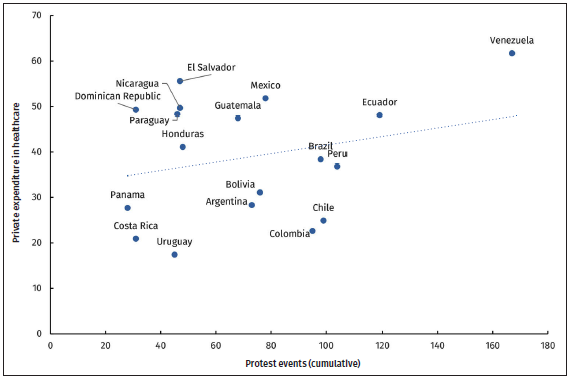
Source: Own elaboration based on Clark and Regan (2019) and CEPAL (2019b)
By 2008 sixteen countries had successfully reduced the share of private health expenditure,
and only in Paraguay and Guatemala it had risen (respectively, +6.0 and +19.6 percent). In Costa
Rica the healthcare system already offered universal coverage to all citizens (including illegal
migrants), which explains the small reduction in private expenditure (Franzoni & Sánchez-
Ancochea, 2016). Bivariate analysis suggests that both protest (r= –0.21) and the share of
left-wing parties (r= –0.28) in parliament were positively associated with larger reductions in
private expenditure in healthcare between 1998 and 2008 (Figure 4).
Figure 4. Relationship between protests and left-wing seats in parliament and change
in share of out-of- pocket expenditure in healthcare, 2010
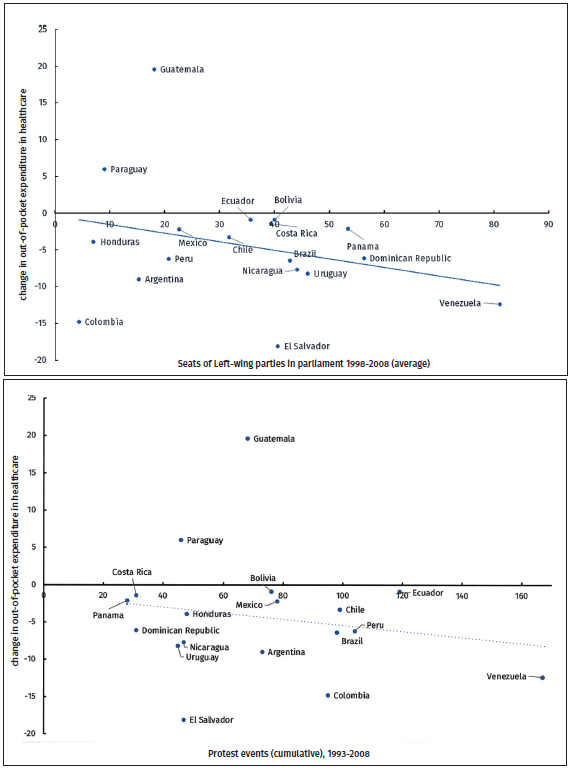
Source: Own elaboration based on Clark and Regan (2019) and Huber and Stephens (2012)
Conditional cash transfers (CCTs) are often considered the centrepiece of the inclusive
turn in Latina American social policies. CCTs combine targeting and human development
goals such as improving children access to education and health. By 2015 there were as
many as 31 such programs in the region covering 20.9 percent of the population (Cecchini
& Atuesta, 2017). Figure 5 shows that the CCTs coverage in 2010 was positively related to
both protest levels and the share of left-wing seats in parliament. Indeed, the correlation
coefficients are similar for both independent variables (0.30), which can be interpreted as
evidence that when protests are more frequent and the left controls parliament, CCTs reach
wider populations.
Figure 5. Relationship between frequency of protests 1990-2009, share of left-wing
eats 1998-2008 and coverage of CCTs, 201
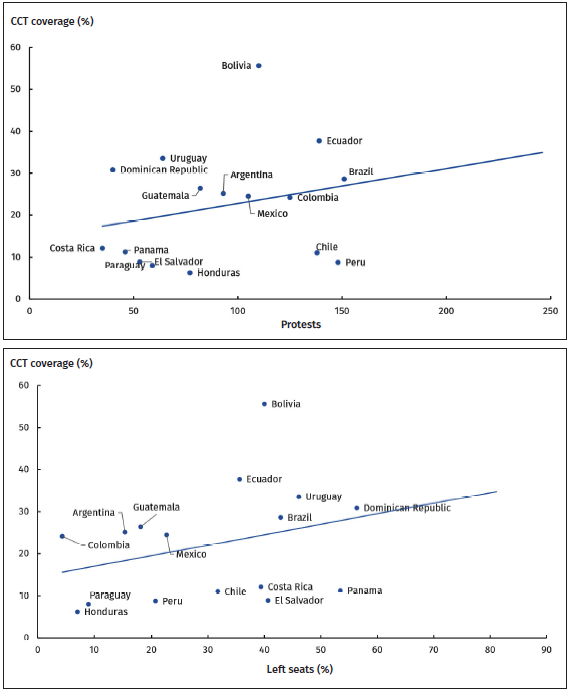
Source: Own elaboration based on Clark and Regan (2019), Cecchini and Atuesta (2017) and Huber and
Stephens (2012)
Looking at the levels of benefits (Figure 6), we observed a correlation with the share of
left-wing seats in parliament (0.35) but no relationship with the frequency of protest (-0.01).
This suggests that while protests were influential in shaping the inclusion of a higher number
of social groups (coverage), the electoral strength of the Left was an important condition
determining the generosity of CCTs. However, Uruguay, Costa Rica, Brazil, Ecuador, El Salvador,
Bolivia showed very dissimilar levels of benefit despite a similar share of left-wing seats in
parliament, indicating that further conditions were necessary to produce this outcome.
Figure 6. Relationship between protests 1990-2009 and left-wing seats 1998-2008
in parliament and maximum benefit per capita of CCTs, 2010
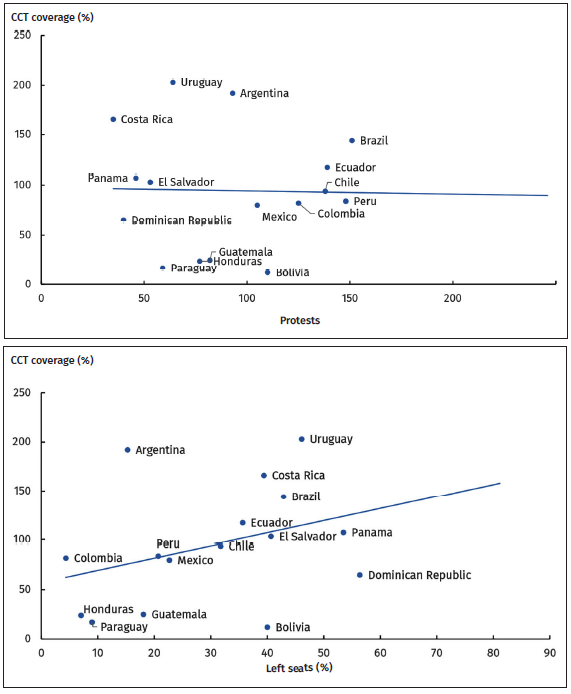
Source: Own elaboration based on Clark and Regan (2019), Cecchini and Atuesta (2017) and Huber and
Stephens (2012)
Non-contributory old-age pensions is another area where there has been considerable
policy innovation in the 2000s. Figure 7 shows that both the frequency of protests (r= 0.21)
and the share of left-wing parties in parliament (r= 0.24) had a positive influence on pension
coverage. The more frequent the protests and the higher the share of parliament held by the
left, the larger the increase in coverage. Bolivia stands out here for providing nearly universal
coverage, although other countries with similar levels of protests (Argentina) and presence of
the left in parliament (Costa Rica, El Salvador, Uruguay) presented limited coverage.
Figure 7. Relationship between protest 1990-2009 and left-wing seats 1998-2008
in parliament and coverage of non-contributory pensions, 2010
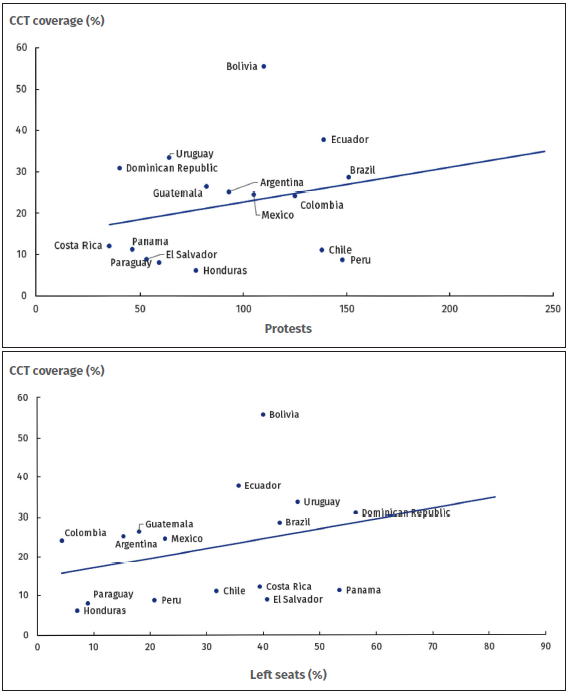
Source: Own elaboration based on Clark and Regan (2019), Huber and Stephens (2012) and CEPAL (2019a)
To conclude this analysis, we look at benefit levels of non-contributory old-age pensions
(figure 8). We observe a strong positive relationship between the maximum amount of
benefits and both protest levels (r= 0.55) and the share of left-wing seats in parliament
(r= 0.64). This suggests that the generosity of benefits has been generally higher in countries
where protests have been intense and parliaments exhibited a higher presence of left-wing
politicians.
Figure 8. Relationship between protest and left-wing seats in parliament and
maximum benefit per capita of non-contributory pensions, 2010
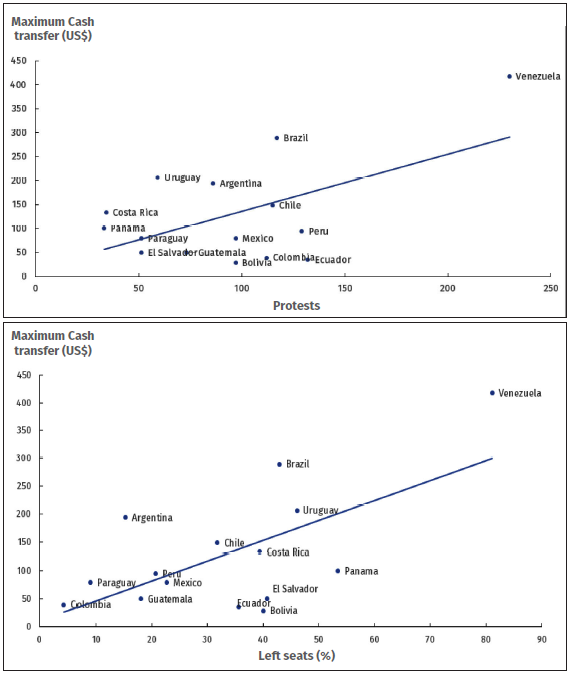
Source: Own elaboration based on Clark and Regan (2019), Huber and Stephens (2012) and CEPAL
(2019a)

